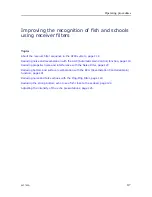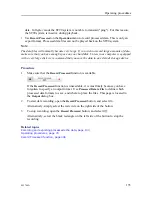
442704/A
121
3
Select
Noise Filter
.
4
Select a value from the options provided.
Related topics
Operating procedures, page 79
Improving the recognition of fish and schools using receiver filters, page 117
Noise Filter function, page 488
Reducing bottom and surface reverberation with the RCG
(Reverberation Controlled Gain) function
When you transmit an acoustic pulse into the water to search for a target, echoes will also be
returned from any other objects in the beam. The energy reflected from these "unwanted"
objects is referred to as
reverberation
. Reverberation is often a limiting factor, especially if
you are searching for smaller targets.
Context
Reverberation is often regarded as noise.
There are several types of reverberation.
Volume reverberation
The volume reverberation is caused by minute plankton and air-bubbles in the water.
This reverberation has often daily cycles in intensity.
Surface reverberation
The surface reverberation depends on the weather condition and the waves.
Bottom reverberation
The bottom reverberation depends on the roughness and physical properties of the
sea bottom.
The
RCG
(Reverberation Controlled Gain) controls the receiver processing. The algorithm
handles each receiver beam individually. The filter reduces the unwanted echoes from the
bottom and from the sea surface. This enhances the visibility of schools.
Note
The numerical settings do not express an increasing filter strength. They represent specific
settings using different algorithms.
Summary of Contents for Simrad ST90
Page 1: ...kongsberg com simrad Simrad ST90 REFERENCE MANUAL ...
Page 2: ......
Page 337: ...442704 A 335 Related topics Sonar views page 326 User interface ...
Page 413: ...442704 A 411 Related topics Menu system page 375 Display menu page 384 Menu system ...
Page 631: ...442704 A 629 Related topics Concept descriptions page 626 Concept descriptions ...
Page 687: ......
Page 688: ... 2021 Kongsberg Maritime ISBN 978 82 8066 211 8 ...
Page 689: ......
Page 690: ...Reference Manual Simrad ST90 ...






























